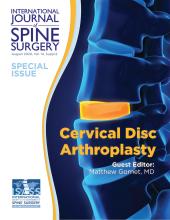ABSTRACT
Background: Multiple studies have highlighted the motion-sparing benefits of single-level cervical disc arthroplasty (CDA) compared with anterior cervical discectomy and fusion (ACDF). However, few studies have reviewed multilevel ACDF versus CDA. Several recent studies have midterm and even long-term data available comparing 2-level ACDF versus CDA.
Methods: We reviewed 3 reports from 2 large randomized, prospective Food and Drug Administration investigational drug exemption trials looking at 2-level CDA versus ACDF, which provide the bulk of the available midterm to long-term, high-level evidence for the topic. We also present several smaller and/or shorter-term studies.
Results: One 5-year study showed that, while both CDA and ACDF showed significant improvement in patient-reported outcome scores, CDA demonstrated greater improvement in Neck Disability Index (NDI) scores than ACDF (mean = −37 versus mean = −28, P = .0003), were more likely to be satisfied (96.4% versus 89.5%, P = .04), had fewer secondary surgeries (4% versus 16.2%, P = .0003), had fewer adjacent level reoperations (3.1% versus 11.4%), and developed less adjacent segment degeneration (50.7% versus 90.5%, P < .0001). Adverse events occurred more frequently with ACDF (8.6% versus 4.4%).
Similarly, Lanman et al [Lanman TH, Burkus JK, Dryer RG, Gornet MF, McConnell J, Hodges SD. Long-term clinical and radiographic outcomes of the Prestige LP artificial cervical disc replacement at 2 levels: results from a prospective randomized controlled clinical trial. J Neurosurg Spine. 2017;27(1):7–19] showed that, at 7 years, while both groups demonstrated improvement in patient-reported outcomes, CDA had greater improvement in regard to NDI, neck pain, and Short Form (36) Physical Component Summary scores (each P < .001), had higher rates of satisfaction (94.8% versus 92.6%), had lower rate of secondary surgery at treated levels (4.2% versus 14.7%), and had a lower, albeit not statistically significant, rate of secondary surgeries at adjacent levels (6.5% versus 12.5%). Adverse events were more common with ACDF (7.2% versus 3.2%).
More recently, Gornet et al [Gornet MF, Lanman TH, Burkus JK, et al. Two-level cervical disc arthroplasty versus anterior cervical discectomy and fusion: 10-year outcomes of a prospective, randomized investigational device exemption clinical trial. J Neurosurg Spine. 2019;31:508–518.] in 2019 reported 10-year data from the same clinical trial as the Lanman et al report comparing 2-level CDA (209 patients) versus ACDF (188 patients). With >84% follow-up for both groups at 10 years, they found that CDA demonstrated a statistically significantly improved rate of overall success (84% versus 62%) as compared with ACDF. Greater improvements were seen in several other outcome measures for CDA, including NDI, neurological success, and neck pain scores. The CDA group had a lower rate of serious implant-related adverse events and demonstrated a lower rate of needing a secondary surgery at an adjacent level, 9% versus 18% in the ACDF group.
Conclusions: Results of 2 large randomized trials suggest similar-to-improved patient reported outcomes for multilevel CDA versus ACDF maintained out to midterm to long-term follow-up of 5–10 years, with lower rates of revision surgery at index and adjacent levels and lower rates of serious adverse device-related events.
Level of Evidence: 5.
Clinical Relevance: Comparison of the safety and efficacy of multi-level cervical disc arthroplasty and cervical discectomy and fusion.
Footnotes
Disclosures and COI: Z.H.G.: None. B.B.: Personal fees from Innovative Surgical Designs, outside the submitted work. R.S.: Personal fees from Medtronic, outside the submitted work.
- This manuscript is generously published free of charge by ISASS, the International Society for the Advancement of Spine Surgery. Copyright © 2020 ISASS.







